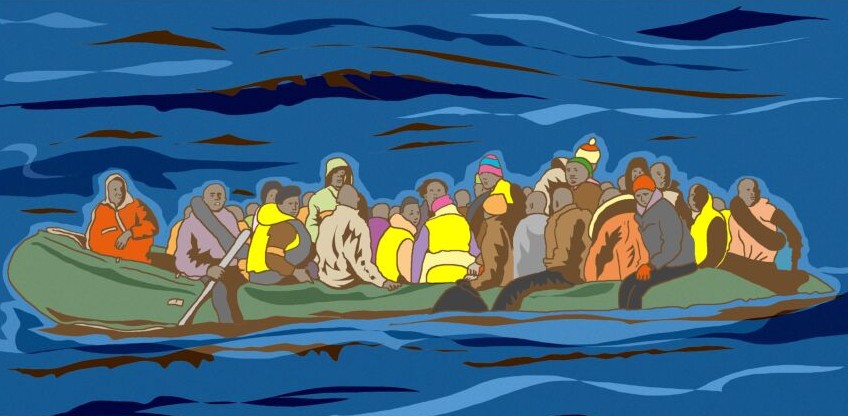West African radio
Message from Benin’s Radio Ecole APM
[ By Jonathan Marks ]
Five bottles of water; some ginger sweets; a high-definition camera and batteries; malaria tablets; overnight stuff; a box of tee-shirts as presents and 50,000 CFA francs. Late last year, I was packing my things for a trip to Benin, Togo and Ghana. Trawling the web, I was amazed to discover that Google Earth 5 could pinpoint our departure point, slightly east of the commercial centre of Cotonou, to within a few metres. It was even possible to count the air-conditioners on the roof and see how the beach nearby had been eroded over the past five years.
Almost three years earlier, a major decision was taken at the Geneva-based headquarters of the International Telecommunication Union (ITU), which plays a vital role in the global management of the radio-frequency spectrum and satellite orbits. In July 2006, all member states in Europe, Africa and the Middle East (including Iran) signed a treaty to switch to digital broadcasting by 2015.
Part of my mission in West Africa last year was to evaluate how that can possibly happen, when no money seems to be available to help FM radio stations, promoters and listeners to make the switch. The ITU decisions were taken when the world economy was in a much better shape than it is now.
The other part of the mission was to build the second phase of Radio Ecole APM, based in Porto Novo, the official capital of Benin. This centre was established several years ago as an accredited training institution for journalists and broadcasters. Now, with the vast changes in digital production, as well as the growth in mobile communication, Benin’s association of media professionals APM (Association pour la Promotion des Médias) is building on what’s already running. Practical experience gained in its media lab is being used to advise around 40 community media stations in Benin, and 100 others in neighbouring countries. They look at emerging technologies and see how these apply to situations in Africa, where climate and financial models are very different.
Local needs
Discussions with African colleagues reveal that the biggest challenges we all face may not be to introduce new ideas, but how to eradicate the old ones. From a practitioner’s point of view, the single deadline for all of Europe, Africa and the Middle East looks absurd. No two countries are ever at exactly the same point in their media development. The factors that determine whether the industry grows or declines are complex and intertwined with factors like legislation and the growth of telecom.
Many community and regional broadcasters are blunt about what kind of help they want: sustained support. Jerome Carlos, the manager of Cotonou’s CAPP FM, says: “Many non-governmental organisations have given us equipment – and with it, an impossible deadline to become sustainable through advertising within three years.” The NGOs seem to believe that owning the hardware is enough to achieve that.
Carlos says that is not so: “In fact, such a donation is like loaning someone a car. If there is no regular maintenance – and a constant supply of fuel – things very quickly go wrong.” According to him, rule number one is always to closely consider the local situation. In Benin, he believes, it will normally take five to six years for a station to make an impact and move towards anything like sustainability. This is all the more so, he argues, as the global economic crisis is affecting West Africa, a region that depends on international trade and remittances from the diaspora.
Apart from technology, many stations could also need advice on management matters. They need business plans to change equipment systematically and efficiently. And, at some point, they have to work with professional staff. Unless journalists and producers can make a decent living from their work, a station will not last. Those that rely only on volunteers quickly collapse.
The business dimension is crucial. “We are never going to get public or state-financed broadcasting in this region of the country,” says Rodrigue Azinnongbe, the director of Radio Fraternité, a commercial station based in Parakou in northern Benin. He points out that the industry’s future is linked to the expansion of the mobile phone industry: “Remember that in many countries of East and West Africa, you can transfer credit from one phone to another.”
Some radio stations are offering to charge a listeners’ mobile phone if they stop by the station and either buy an announcement or bring a piece of news. Top-credit and information are becoming new forms of social currency. Radio Fraternité has purchased some sophisticated software to manage incoming SMS’s to the station and also to provide relevant SMS services to a local telecom provider. Radio Fraternité did a deal with the local state lottery. “If you call our station with the right mobile phone company, then there’s a chance to win free mobile calls for five years,” reports Azinnongbe.
There’s no doubt that African broadcast media is growing fast, just like it did in Latin America a decade ago. Growth has two dimensions. First, national commercial and state networks are renewing old equipment since everyone can see that the analogue production is much more expensive to maintain than the digital equivalent. Second, there is much more media activity at the local and regional level. A major difference to Latin America at this level, however, lies in the attitude to language.
In Latin America, the Spanish and Portuguese languages predominate. Even though there are 10 million speakers of an indigenous languages like Quechua, the population is underserved with programmes in those languages. Neither commercial nor state-public broadcasters invest in vernacular programmes, knowing they will reach most people in Spanish or Portuguese.
Linguistic communities
In Africa, the situation is very different. Broadcasting on this continent was introduced by European colonial powers as a means to keep their empires together. In some African countries, the national broadcaster still maintains a monopoly, and it usually serves as the mouthpiece of the government. But there are also countries where democratic change is happening, partly thanks to the role of the media as a catalyst for conversation. African community media has grown because of a need to communicate in local languages.
Linguistic communities are not confined by national borders, moreover. “In Benin alone we have 42 ethnic groups, the most prominent being Fon, Adja, Yoruba and Bariba,” says Soulé Issiaka, the manager of the Africa Office at Radio Netherlands Worldwide. These ethnic groups cut across many of the political borders established during the period of European colonial rule.
Accordingly, a station like Deeman Cultural Radio 90.2 MHz in Parakou has a large and relevant audience in neighbouring Nigeria. With the money it gets from an estimated 100,000 Bariba-speaking people there, Deeman can even afford to hire presenters from over the border, too. “Do not underestimate the power of entrepreneurship in Africa, even in these harsh economic times,” says Issiaka.
He stresses the relevance of community media. “In Europe, you have around 200 languages, across the continent of Africa we have more that 2000, one third of the world’s linguistic heritage. If you want to get a message across to the majority of the population you will not succeed with just French or English.” Issiaka argues that the success and growth of community media is crucial to the stability of entire countries in West Africa, and especially for Nigeria, the most populous of all.
Collective memory
Indeed, this part of the world is steeped in oral tradition, with knowledge being passed from one to another through spoken word rather than textbooks. That’s why electronic media, radio in particular, has been such a powerful force, especially because it is cost-effective to make programmes for relatively small numbers of listeners. Local TV production in these languages is not economically viable, despite the dramatic drop in the cost of production equipment.
It would be wrong to believe that the role of broadcast media is only to cover current events. It also has the important task to take items from the past and put them into a context for today. To a large extent, the media serve as a kind of collective memory in contemporary society.
There is a saying that when an old person dies in Africa, so does an important part of the continent’s heritage. Having seen the state of many tape archives in Africa and Latin America, I can only confirm the UNESCO statistic that 80 % of the world’s archives are in a mess. To some degree, this is a technological challenge that can be mastered. Digital storage costs have fallen dramatically, with one TB costing less than € 100 in March 2009.
Technology is therefore no longer a barrier to solving what is, in effect, the onset of a sort of global cultural “Alzheimer’s” disease. Unless community media are aware of the challenges, however, they will not rise to them. They should set up archives, and develop broadcast formats to systematically use the stored data. No doubt, there is a need to develop capacities.
Distance education is becoming more and more vital in developing countries. Its importance can only increase, as local populations have to adapt their livelihoods as a result of global warming, and the climate change it brings with it. Information and debate on how to adapt is already providing a lifeline in sub-Saharan Africa, especially along the West African coast affected by enhanced coastal erosion.
Yet, many stations are not preserving great talks and features in local languages because, until now, no easy way has been found to catalogue this great wealth of knowledge. Hopefully, some of the universities in Africa will take on this role and the number of students outside the campus continues to grow. In Benin, Radio Ecole APM lab has been experimenting with making automatic recordings of features and logging the details with radio-frequency identification (RFID) cards. Professors swipe their security pass to switch the lights on in the lecture theatre. In doing so, they start a recording and provide data needed to identify the material later.
Outlook
Digital transmission is not the most urgent issue for broadcasters and their audiences in West Africa. Most stations already use digital production, though the transmission chains remain analogue.
At present, there is neither the incentive nor the money for audiences to want to change to digital transmission systems like DAB or HD-Radio. The FM band is not overcrowded. FM radios can be purchased for as little as four euros at the market, so batteries to keep the device going are more expensive than the initial investment.
The distribution technology will be different in other areas, though. Larger countries where the population spreads out, like Ethiopia, are building new medium-wave transmitters to re-establish national coverage on AM. They might go digital one day, at least they can be converted at low cost.
For other purposes, the internet is of growing relevance. Kenyans, for instance, have begun to use the internet to serve diasporas abroad, with commercial success. The expats, after all, contribute significant funds to the national economy.
For a variety of reasons, the single ITU deadline to “go digital by 2015” is going to be very demanding for radio, especially if broadcast receivers are still too expensive.
It would be a shame if funds were used to artificially accelerate a digital changeover in distribution, rather than helping to enhance the quality and reliability of local digital productions. After all, the future of radio is serving a community of interest, both in Africa and the rest of the world.







